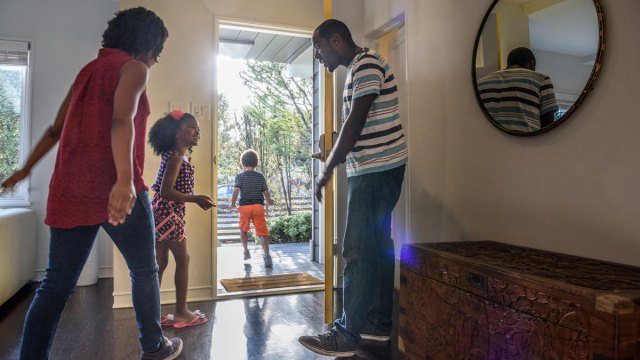We were late again.
The daily morning chaos had unfurled in all its glory: Oldest Child was refusing to eat breakfast (this time because of a newly erupted canker sore); Middle Child was lackadaisically searching the house for his shoes, which would inevitably be found a full five minutes later right by the door. Youngest Child, always barefoot, was insisting we find her Aurora doll before we leave.
And there I was, just willing them to hurry up, like usual. Standing against the doorway holding three backpacks, three winter coats, and a pair of toddler boots, I waited.
“We’re going to be late!” I called.
“Come on!” I yelled.
“Let’s go!” I insisted.
Eventually, the three of them ambled downstairs and shuffled out the door, the two older boys bickering with each other about something I didn’t have the patience to decipher. And when Middle Child whimpered something about being late, I shrugged my shoulders and said, “It is what it is. Next time we’ll do it differently.”
And we will. Because as of that moment, I decided that I’m done rushing my kids around.
At least, I’m going to try. Because what good does it do? Sure, in this instance, we might have made it to school on time. But isn’t it better to just accept that we’re late and face the inevitable consequences (in this case, a tardy slip and an embarrassing solo walk into the classroom)? Isn’t the best solution to figure out a way to get them out the door earlier? To leave room for dawdling because, well, that’s just what kids do?
Experts agree. In this Psychology Today article by Dr. Laura Markham, author of Peaceful Parent, Happy Kids, she says that rushing our children “interrupts their developmental work of exploring the world, so they lose their curiosity.” She also says that hurrying kids from one place to another can “habituate them to busyness.”
In other words, they’ll be bored with life at a regular pace. Furthermore, rushing them can also cause anxiety. They’re human after all, and always feeling like you’re going to be late is stressful for anyone, big or little.
Kids don’t rush. They probably don’t get why we grownups always do. For a kid, walking to school is a time to explore (even if you’re late). Leaving the playground is still, after all, time at a playground (even if Mom is ready to go). Getting in and out of the car is a time to dawdle (even if it makes Mom crazy). Simply: life is for living.
It’s us grownups who have it wrong.
Last week my three-year-old threw a tantrum because I wouldn’t let her stop and visit our next-door neighbor when we pulled into our driveway at the end of the day. And yesterday she wanted me to chase a woman halfway down our block because she wanted to pet her doggie. I said no both times because I just wanted to go inside and put everything down (the backpacks, half-eaten snacks, and trash that I’m always fishing out of the car at the end of the day). Meanwhile, if we had done it her way, we would have strengthened our friendships with the neighbors and maybe made a new friend.
Today, I tried it differently. On the last few blocks of our way to school, I let my daughter get out of the stroller. It sounds like it shouldn’t be a big deal, but we’ve got a mile-long walk to school—if she walked it, we’d have to leave at sunrise.
At first, she held my hand, and we walked together. This is nice, I thought. I can do this. Then, she broke free. She leaped onto the grass. She hopped atop a low garden wall and walked, balance-beam-style, the whole length of it, her arms stretched out like a poised gymnast. She stopped to pick flowers, handing me one and saying, “Mommy, will you marry me?” (because she thinks that’s what people do when they get married). In short, she did what kids are supposed to do, which is to simply delight in the world.
And even amid the adorableness of it all, even while I knew that this was the right way to mother her, I felt my bubbling impatience, my desire to hurry. But I held it in. I tried to be there with her because she deserved to enjoy every inch of that walk. Every moment.
This isn’t all to say it’s okay to let our kids be irresponsible or that it’s okay to be late to school. But we parents need to give them more time to get there. More time to find their shoes, pick flowers, tie their own laces, or zip their own jackets so we don’t get frustrated and take those learning experiences from them.
“Rushing costs us,” Markham says on her blog. “It stresses us out, so we enjoy our children less. It makes us less patient, so it’s hard to feel good about our parenting.” So how do we do it? Here are six things I’m going to try:
Leave more time for transitions
Leave for school or activities at least 15 minutes early to give kids the ability to take their time.
Make park dates longer
Try to make your playground visits last. If we only block out a half-hour for a playground visit, our kids will probably be resistant to leave (and we’ll end up frustrated). Stay longer, so kids are ready to go when it’s time.
Shift the evening schedule earlier
This one is going to be hard for us because our evenings with three little ones are pure chaos. But I figure if we have dinner at 5 p.m., we can get our kids to bed by 6:30 or 7 p.m., which will give them an hour or two to read or play in their rooms before lights out (and before I totally lose it).
Find time for quiet
Teach kids the value of slowing down by planning time for quiet moments. Go watch the sunset. Color in silence. Lay on the grass and look at the clouds. Sometimes, it’s those silent moments that speak the loudest.
Take leisurely walks
You’d be surprised how much fun kids can have just walking around the block. Let them explore. Let them linger. Smell flowers. Play in the leaves. Let them enjoy the world around them and try to suppress any desire to say, “Come on” or “We have to go.” See how long it takes them to move on naturally.
Be in the moment with them
In those moments when it’s hard to wait, try to stop and see what your children are seeing. Try to find the fun where they find it. Maybe—if we’re lucky—we can learn a little something.

















